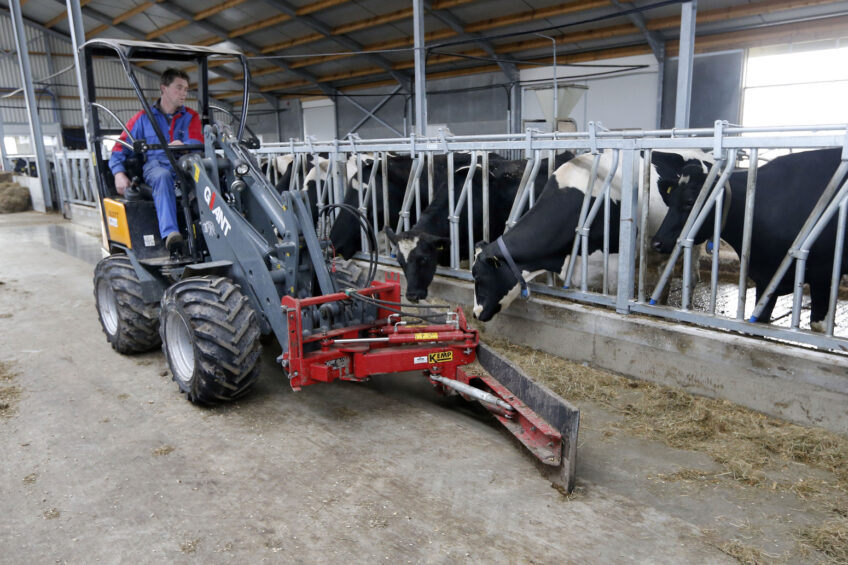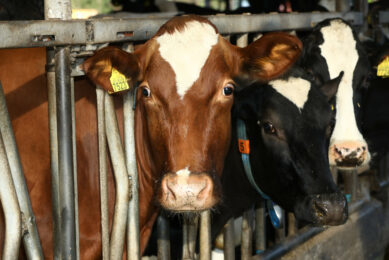Shovel, broom and wheelbarrow

They are a jack of all trades. Mini-shovels in the two tonne category come in handy on almost every farm, as a substitute for a hand shovel, broom and wheelbarrow. Their numbers are rising; an increasing number of companies have discovered the convenience of such a small all-rounder. Once a dairy farmer owns a mini-shovel, he will use it more often than he expected.
Wheel loaders in the 2 tonne category are really made for handling the work in and around the yard. They are generally purchased to muck out stables, baling, or filling the cone blender with loose products. Followed closely by pallet forks, as they are useful for moving a pallet or cubic crate. The vehicles are small and agile and easy to mount and dismount. They are versatile and often used on a daily basis.
Small powerhouses
Despite their compact dimensions mini-shovels are hydraulically strong. Suppliers often see companies who work with mini-shovels, trade in the two tonne machine against a heavy-duty type. Simply because they have discovered the convenience of the machine. Hydraulic lifting capacity usually has no limitation. The weight the shovel can lift is restricted by the machine’s static tipping load. When the rear wheels lift up off the ground, it is not safe to drive it anymore. In its bent state the static tipping load is lower than when the shovel is straight. That is why suppliers prefer the term tipping load full turn over lifting force. Tipping load full turn is the weight at which the vehicle is destabilised. A general purpose bucket in the lift bars allows a shovel to effectively lift more than for instance a pallet fork does, as it shifts the centre of gravity forward. In practice this means a wheel loader can roughly lift half of its own weight. Also the maximal dump height is a point of attention. It is often lower than the lift height sellers indicate.
Wide range
There are a wide range of wheel loaders. Traditionally these are established brands from Germany, but also France, Italy and the Asian countries offer shovels. Originally mini-shovels mainly found their way to contractors, gardeners and pavers. Some shovels can be equipped with a lifting device and in some cases even a power take off for gardeners, who want to use it for tractor work. A farmer usually owns a small tractor, which is more suitable to do the job.
Wide range of quick couplers
Every wheel loader works with a quick-change system for fittings. Especially when a user shifts, often it is convenient when this can be done hydraulically. Fittings can be switched within a matter of seconds without dismounting. Virtually every manufacturer has its own quick-connect coupler. Standardisation hardly exists. As certain brands have been in the market for a long time, some offer the competition’s quick-connect coupler in addition to their own system. This allows the new owner to keep using the accessories of his previous shovel.
Safety requirements Rops and Fops
For mini-shovels safety requirements are regulated in the European Machine Directive 2006/42/EG. This directive states among other things that a machine, such as a tractor, must be equipped with a Roll Over Protective Structure (Rops), more commonly known as a rollbar. A wheel loader also must be equipped with a Falling Object Protective Structure (Fops); a roof which protects the driver when the shovel’s load falls on top of the machine. Protection devices shouldn’t be removed, but in order to enter low buildings, several manufacturers offer a safety frame which can be easily tipped backwards.
Points to consider when purchasing a used shovel
You can’t judge a shovel by its appearance. First impressions play a role when acquiring a used wheel loader, but it is the technical state of the machine that counts. A good machine is leakproof and only has minimum play at the moving parts. The condition of the tyres are easy to check. The actual capacity of the hydraulics is difficult to monitor and only recognised in the case of warm oil and a heavy weight in the bucket. This also applies to the riding hydraulics, which work on a piston pump. This technique is reliable, yet expensive when worn. As with any machinery the availability of good service is of importance. What matters is not what you pay, but the value you get for your money. A number of points can make the difference in case of a possible purchase.
– The amount of available oil for external functions and the presence of an interface for external functions.
– The effective hydraulic lifting capacity of the shovel. Static tipping load (full turn) turns out to be a restriction more often than the power of the lifting cylinders.
– The shovel’s own weight. It also depends on the connected equipment, fullness of the fuel tank and whether or not the driver is taken into account.
– Visibility to the loading arm. This is largely determined by the height of the steering column.
– The accuracy of the parallel guide. This varies per brand.
– Hydraulic motors per wheel or hydraulically driven cardan shafts.
– Measurements of the bracket, the safety frame or the protective roof. This comes as standard and is mandatory, but also determines the maximum workable height.
– Comfort and quality of the seat.
– The pump capacity. It also affects the speed of movement.
– The applied quick-action. That is of importance in case you wish to use existing attachments.
– Lift height doesn’t say everything, what matters is the wheel loader’s maximum dump height.
– Working pleasantly, but above all working safely. This is only possible when the shovel is slightly oversized and – literally and figuratively – not pushed to the limit.
Join 13,000+ subscribers
Subscribe to our newsletter to stay updated about all the need-to-know content in the dairy sector, two times a week.













